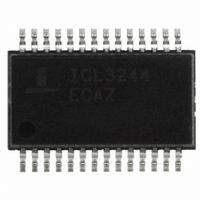ICL3244ECAZ-T Intersil, ICL3244ECAZ-T Datasheet - Page 14

ICL3244ECAZ-T
Manufacturer Part Number
ICL3244ECAZ-T
Description
TRANSMITTER/RCVR RS232 28-SSOP
Manufacturer
Intersil
Type
Transceiverr
Datasheet
1.ICL3244ECAZ-T.pdf
(20 pages)
Specifications of ICL3244ECAZ-T
Number Of Drivers/receivers
3/5
Protocol
RS232
Voltage - Supply
3 V ~ 5.5 V
Mounting Type
Surface Mount
Package / Case
28-SSOP
Peak Reflow Compatible (260 C)
Yes
Rohs Compliant
Yes
Lead Free Status / RoHS Status
Lead free / RoHS Compliant
Other names
ICL3244ECAZ-TTR
Available stocks
Company
Part Number
Manufacturer
Quantity
Price
Company:
Part Number:
ICL3244ECAZ-T
Manufacturer:
INTERSIL
Quantity:
10 071
Interconnection with 3V and 5V Logic
The ICL32XXE directly interfaces with 5V CMOS and TTL
logic families. Nevertheless, with the ICL32XX at 3.3V, and
the logic supply at 5V, AC, HC, and CD4000 outputs can
drive ICL32XX inputs, but ICL32XX outputs do not reach the
minimum V
information.
POWER-SUPPLY
5V/DIV.
5V/DIV.
R1
R1
T1
T1
TABLE 4. LOGIC FAMILY COMPATIBILITY WITH VARIOUS
T1
T1
OUT
OUT
OUT
OUT
VOLTAGE
SYSTEM
IN
IN
3.3
(V)
5
5
V
C1 - C4 = 0.1µF
V
C1 - C4 = 0.1µF
FIGURE 13. LOOPBACK TEST AT 120kbps
FIGURE 14. LOOPBACK TEST AT 250kbps
CC
CC
IH
SUPPLY VOLTAGES
= +3.3V
= +3.3V
for these logic families. See Table 4 for more
VOLTAGE
SUPPLY
V
(V)
3.3
3.3
CC
5
14
Compatible with all CMOS
families.
Compatible with all TTL and
CMOS logic families.
Compatible with ACT and HCT
CMOS, and with TTL. ICL32XX
outputs are incompatible with AC,
HC, and CD4000 CMOS inputs.
2µs/DIV.
5µs/DIV.
COMPATIBILITY
ICL3224E, ICL3226E, ICL3244E
±15kV ESD Protection
All pins on ICL32XX devices include ESD protection
structures, but the ICL32XXE family incorporates advanced
structures which allow the RS-232 pins (transmitter outputs
and receiver inputs) to survive ESD events up to ±15kV. The
RS-232 pins are particularly vulnerable to ESD damage
because they typically connect to an exposed port on the
exterior of the finished product. Simply touching the port
pins, or connecting a cable, can cause an ESD event that
might destroy unprotected ICs. These new ESD structures
protect the device whether or not it is powered up, protect
without allowing any latchup mechanism to activate, and
don’t interfere with RS-232 signals as large as ±25V.
Human Body Model (HBM) Testing
As the name implies, this test method emulates the ESD
event delivered to an IC during human handling. The tester
delivers the charge through a 1.5kΩ current limiting resistor,
making the test less severe than the IEC61000 test which
utilizes a 330Ω limiting resistor. The HBM method
determines an ICs ability to withstand the ESD transients
typically present during handling and manufacturing. Due to
the random nature of these events, each pin is tested with
respect to all other pins. The RS-232 pins on “E” family
devices can withstand HBM ESD events to ±15kV.
IEC61000-4-2 Testing
The IEC 61000 test method applies to finished equipment,
rather than to an individual IC. Therefore, the pins most likely to
suffer an ESD event are those that are exposed to the outside
world (the RS-232 pins in this case), and the IC is tested in its
typical application configuration (power applied) rather than
testing each pin-to-pin combination. The lower current limiting
resistor coupled with the larger charge storage capacitor yields
a test that is much more severe than the HBM test. The extra
ESD protection built into this device’s RS-232 pins allows the
design of equipment meeting level 4 criteria without the need
for additional board level protection on the RS-232 port.
AIR-GAP DISCHARGE TEST METHOD
For this test method, a charged probe tip moves toward the IC
pin until the voltage arcs to it. The current waveform delivered to
the IC pin depends on approach speed, humidity, temperature,
etc., so it is difficult to obtain repeatable results. The “E” device
RS-232 pins withstand ±15kV air-gap discharges.
CONTACT DISCHARGE TEST METHOD
During the contact discharge test, the probe contacts the
tested pin before the probe tip is energized, thereby
eliminating the variables associated with the air-gap
discharge. The result is a more repeatable and predictable
test, but equipment limits prevent testing devices at voltages
higher than ±8kV. All “E” family devices survive ±8kV contact
discharges on the RS-232 pins.













